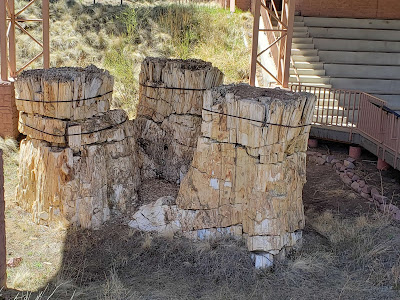"The last rail needed to complete the greatest railroad enterprise of the world is about to be laid. The last spike needed to unite the Atlantic and Pacific by a new line of travel and commerce is about to be driven to its place. To perform these arts, the east and west have come together. Never, since history commenced her record of human events, has she been called upon to note the completion of a work so magnificent in conception, so marvelous in execution ..."
-H.W. Harkness, a Sacramento newspaper publisher and editor, at the "Golden Spike" ceremony
May 10, 1869 - the day that the Transcontinental Railroad was finished.
The trip from the East Coast to the West Coast - which took nearly 6 months - now only took a little more than a week. This created a monumental change in American transportation, economy, technology, communication, and culture.
To learn more about this gigantic project and the NPS unit, here is the link to my previous blog post on our first visit to Golden Spike National Historical Park.
The two lines - Union Pacific Railroad and the Central Pacific Railroad - met each other about 66 miles northwest of Salt Lake City, Utah, at a place called Promontory Point. The Union Pacific Railroad began construction in Omaha, Nebraska and proceeded west (the laborers were predominantly Irish immigrants), and the Central Pacific Railroad began construction in Sacramento, California and proceeded east (the laborers were predominantly Chinese immigrants).
On May 10, 2019, there was a huge celebration commemorating the 150th anniversary of this great accomplishment. Tara and I went with Tara's parents. There were lots of great temporary exhibits set up detailing the history of the project, the culture of the American West, and how the completion of the transcontinental railroad changed the nation.
As the construction neared its completion, four special spikes were made to be presented at the ceremony: a Golden Spike from California; Silver Spike from Nevada; and a gold and silver spike from Arizona.
On May 10, 1869, the ceremony began, emceed by wealthy Sacramento banker Edgar Mills. Two locomotives - the Union Pacific No. 119 and the Central Pacific Railroad #60 AKA "Jupiter" - were brought to the meeting point. Speeches were delivered by (1) Dr. H.W. Harkness, a Sacramento newspaper publisher; (2) Leland Stanford, Governor of California, and President of Central Pacific Railroad; and (3) Gen. Grenville Dodge, Union Pacific Railroad's Chief Engineer. The four special spikes were officially presented to Stanford. They were placed in the tie and given gentle taps by a silver-plated hammer known as a maul, for ceremonial purposes only. The precious spikes were then taken out and replaced by actual railroad spikes to place in the ties. The last spike, and the hammer, were wired to a telegraph line so the entire Nation could "hear" the blows driving in the spike as it happened. It was essentially the first mass-media event. Stanford was given a chance to hammer the last spike, but his swing missed the spike and hit the tie instead. Union Pacific Vice President Thomas Durant was also given a chance to hammer the spike. But Durant had partied hard the night before, and had a severe headache. He did worse than Stanford, his swing was so off, not only did he miss the spike...but he didn't even hit the tie! 😀 Finally, an actual laborer stepped in and officially completed the railroad. The telegrapher then sent the long-awaited message "D-O-N-E" on Monday, May 10, 1869 at 12:47 pm.
The golden spike is now located at Stanford University. However, the Visitor Center at the NPS site does have a replica of the golden spike.
We had a great time at the celebration, there was lots of live music, tributes to the sacrifice of the laborers who made the railroad possible, and a fun show with music and dancing. The replicas of the locomotives are truly beautiful and fantastic. I recommend heading to Golden Spike National Historical Park to see the re-enactment of the ceremony. They are held throughout the summer.











































































































